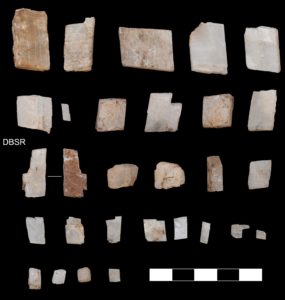Archaeological evidence in arockshelterat the edge of the KalahariDesert,South Africa,is challenging theidea thattheoriginsofourspecieswere linked to coastal environments.

Dr Jayne Wilkins.
Published inNature,Dr Jayne WilkinsfromGriffith University’sAustralian Research Centre for Human Evolutionledan international collaborationwhichfoundevidencefar from coastal sitesofthe complex symbolic and technological behaviours thatdefine modern humans, stretchingback 105,000 years.
“Our findingsfrom thisrocksheltershowthatoverlysimplifiedmodels for the origins of our speciesare no longer acceptable. Evidence suggestsmany regions across the African continentwereinvolved,the Kalaharibeing just one,”Dr Wilkins said.
“Archaeological evidencefor earlyHomosapienshas been largely discovered at coastal sites in South Africa,supportingthe idea that our origins werelinked to coastal environments.Therehave beenvery few well-preserved, datable archaeological sites in the interior of southern Africa that can tell us aboutHomosapiens’origins away from the coast.
“ArockshelteronGa-Mohana Hillthat stands above an expansive savannahin the Kalahariis one such site.”
Used asa place of spiritualactivitiestodaybysomeof thelocal community, archaeological researchintherockshelterhasrevealeda long history as a place of spiritual significance.
The researchers excavated 22white calcite crystalsand fragments of ostrich eggshell, thought be used aswatercontainers,from deposits datedto 105,000 years ago at Ga-Mohana HillNorthRockshelterwhen the environment was much wetter than today.
“Our analysis indicatesthat the crystals were not introduced into the depositsvia naturalprocesses, butwere deliberately collected objectslikelylinked to spiritual beliefs and ritual,” Dr Wilkins said.
“The crystals point towardsspiritual or culturaluse of the shelter 105,000 years ago,”said Dr SechabaMaapefrom theUniversity of the Witwatersrand.“Thisis remarkable considering thatsitecontinuesto be used to practiceritualactivitiestoday.”
The researcherswere delighted to discover thattheassemblage of human-collected crystals and ostrich eggshell fragments at Ga-Mohana Hill were significantly older than that reported ininterior environments elsewhere.
“At coastal sites, the earliest evidence forthesekindsof behaviourdate to aboutthe same time, 105,000 years ago,”Dr Wilkins said.

Crystals collected by early Homo sapiens in the southern Kalahari 105,000 years ago.
CREDIT: Jayne Wilkins
“This suggeststhat early humans in the Kalahari were noless innovative than those on the coast.”
The chronology of Ga-MohanaNorthRockshelterwasdetermined by the research team using luminescence dating.
“This techniquemeasuresnatural light signals that accumulateovertime in sedimentary quartz and feldspar grains,” saidDrMichael Meyerfrom theUniversity of Innsbruck.
“You can think about each grain as a miniaturised clock, from whichwe can read outthis natural light orluminescence signal,giving usthe age of thearchaeological sediment layers.”
Due to the ongoing spiritualsignificanceofGa-Mohana Hill,the researchersareconscious tominimisetheir impact on thelocal communities’use of therockshelterafter each season.
“Leaving no visible trace and working with the local communityiscritical for the sustainability of the project,”DrWilkinssaid.
“So that Ga-Mohana Hill can continue to provide new insights about the origins and evolution ofHomosapiensin theKalahari.”

